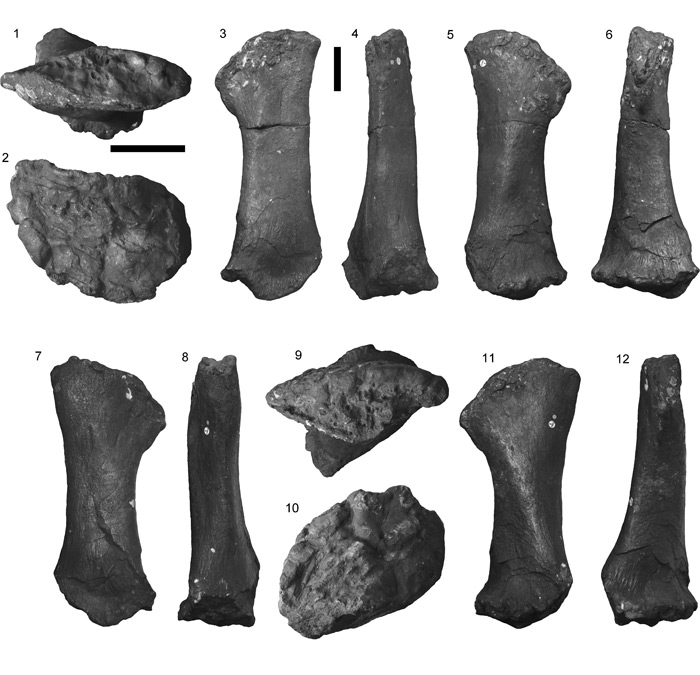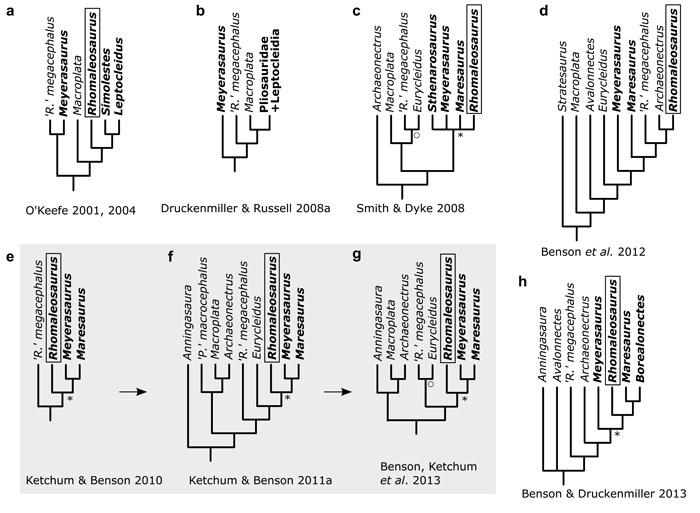Monograph on Rhomaleosaurus thorntoni
Many readers will be familiar with the giant plesiosaur on display in the marine reptiles gallery of the Natural History Museum, London. This is a cast of the 7 metre long holotype of Rhomaleosaurus cramptoni, the original of which is housed in the National Museum of Ireland (Natural History) and formed the basis for my PhD thesis back in (time flies!) 2007. However, The Natural History Museum, London, also has its very own massive (also ~7 m long) and quite real Rhomaleosaurus type specimen to rival the ‘Dublin Pliosaur’ in size. NHMUK PV R4853, the mighty Rhomaleosaurus thorntoni, is from the Toarcian (Lower Jurassic) of Northamptonshire. It was donated to the museum prior to 1922 but has never been described and figured in its entirety before.

My newest paper, co-authored with Roger Benson (Smith and Benson 2014), provides a detailed description and photographic atlas of the entire skeleton of Rhomaleosaurus thorntoni, and it was published by the Palaeontographical Society just in time for me to distribute copies to colleagues at the SVP annual meeting in Berlin last November (2014). Few monographs of this kind, i.e. a comprehensive treatments of a single taxon, exist for plesiosaurians, especially up-to-date ones, so the paper should prove useful. The monograph includes 35 photographic plates depicting, essentially, every bone in the skeleton from multiple angles. We describe the skeleton in detail and figure the more complicated elements as interpretive illustrations. It’s just a bigger than average descriptive paper, really, but one that has been many years in the making (even more than it usually takes!). I’ve been waiting for the published monograph to be listed on the Palaeontographical Society publications page prior to posting this article, but since it is not yet forthcoming I decided to post this anyway. I’ll update this blog entry with a link to the volume once it is listed. [Edit – here is the link]:

The entire manuscript, including the photographs and figures, is completely new: this is not a rehash of my PhD thesis on Rhomaleosaurus. The skeletal reconstruction is brand new as well and I hope that it comes to replace my previous reconstruction of Rhomaleosaurus in time, which I was never completely satisfied with (figured in Smith 2007, Smith & Dyke 2008, and Smith 2013). It is important to highlight that the new reconstruction represents R. thorntoni specifically, which we demonstrate is a distinct species, whereas the previous reconstruction represented Rhomaleosaurus sp. using R. cramptoni where possible and R. thorntoni as a proxy where not. As such, the original reconstruction was a mishmash of two different species, with related scaling errors. Most of the differences apparent between the new and old reconstructions are, however, due to stylistic improvements and a greater attention to detail, rather than genuine anatomical differences between R. cramptoni and R. thorntoni. The lateral view, especially, had some perspective issues with the ribs and limbs, which are corrected in the new reconstruction. There is still some margin for error in the proportions of the tail and neck in the new reconstruction because these are incomplete in the holotype (and only known specimen) of R. thorntoni, but I’m much more satisfied with it.

There is some doubt over the systematic position of rhomaleosaurids. They are traditionally regarded as pliosaurs, but they might not really be included within that clade, so for this reason we refrained from referring Rhomaleosaurus to Pliosauroidea in the title. We don’t include a cladistic analysis in our monograph to investigate this question, but we do summarise all previous ones and identify areas of relationship consensus within the clade Rhomaleosauridae. More cladistic work is required to confirm whether rhomaleosaurids are an early plesiosaurian offshoot, or pliosaurs proper.

So, where’s the PDF? Sadly, there isn’t one, and this has been discussed and debated in some detail over at SV-POW (here). I say ‘there isn’t one’, but what I really mean is that distribution of the PDF is forbidden, since a beautiful PDF does exist (I was annotating it in the final proof stages). I was hopeful that permission would be granted for me to share the final PDF along with the hard copies provided for authors to distribute, but it was not to be. Of course, I’m disappointed about the barrier this puts between my research and potential readers, and I’m concerned about the impact this might have on it being cited. However, the hard copy is a quality publication, which can be thought of as more of a book than a paper. Those individuals that require it for research purposes can always request one from me directly – I can’t make promises but drop me an email if you have a serious interest ([email protected]).
The Palaeontographical Society funded some of my visits to the Natural History Museum to see the fossil material and this influenced my decision to select the Monograph of the Palaeontographical Society as a publication venue for this work. Plus, the format suits such an exhaustive treatment. I’d like to thank the editor, Yves Candela, who made a significant contribution to the volume and coordinated the whole process.
Update: The monograph is now available for sale from the Pal Soc website here.
References:
Smith, A. S. 2007. Anatomy and systematics of the Rhomaleosauridae (Sauropterygia: Plesiosauria). PhD thesis. University College Dublin, 278pp.
Smith, A.S. 2013. Morphology of the caudal vertebrae in Rhomaleosaurus zetlandicus and a review of the evidence for a tail fin in Plesiosauria. Paludicola 9 (3): 144–158.
Smith, A.S. and Dyke, G.J. 2008. The skull of the giant predatory pliosaur Rhomaleosaurus cramptoni: implications for plesiosaur phylogenetics. Naturwissenschaften, 95, 975-980.
Smith A.S. and Benson R.B.J. 2014. Osteology of Rhomaleosaurus thorntoni (Sauropterygia: Rhomaleosauridae) from the Lower Jurassic (Toarcian) of Northamptonshire, England. Monograph of the Palaeontographical Society, London: 168 (642), 1–40, pls 1–35.

The monograph is now for sale so I’ve updated this article with a link.
It’s interesting comparing the skeletals (old and new) by lining them up so I can flick back and forth with alt-tab and see the differences clearly.
I notice there are differences in the soft tissue outlines (‘fins’ on the tail, trailing edges of the flippers). Are those significant or just stylistic differences?
Someone needs to do for marine reptiles what Mark Witton did with his ‘Pterosaurs: Natural History, Evolution, Anatomy’.
Yes, the differences to the skeleton all add up, and the changes to the soft tissue outline were intentional. The revised tail shape reflects recent work on this region in plesiosaurs. I also felt that I’d underestimated the soft tissue around the limbs in the first reconstruction, so beefed it up. There’s a certain amount of artistic licence.
If I had time to write a popular plesiosaur book, I would! Maybe one day…